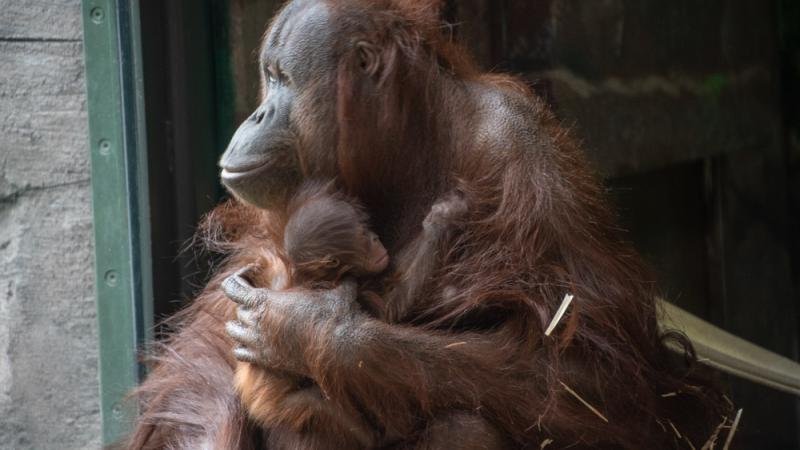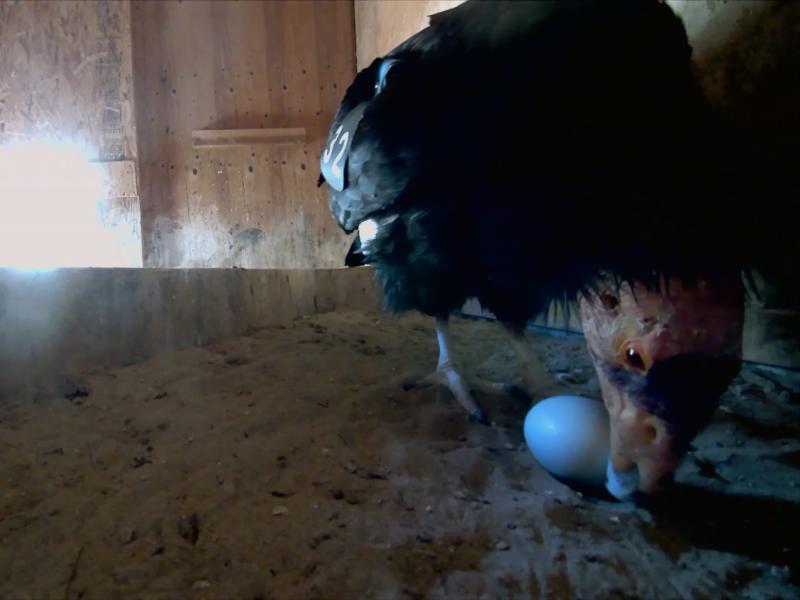Zoo welcomes new Bornean orangutan baby

First-time mom Kitra and her new baby are doing well, caregivers say
The Oregon Zoo’s primate family grew by a few pounds on Wednesday morning as 20-year-old Bornean orangutan Kitra gave birth to a new baby, adding to the world population of this critically endangered species.
Caregivers said the newborn entered the world on April 13, at around 11 a.m. The first-time mom and her new arrival are doing well in their behind-the-scenes maternity den.
“We’re all pretty excited about it,” said Kate Gilmore, who oversees the zoo’s primate area. “It’s great to see Kitra taking such good care of her baby. There’s still a lot that could happen, so we’re being very cautious and giving her as much quiet time as possible. But so far she seems to be taking to motherhood quite well.”
“We couldn’t ask for anything more,” agreed senior keeper Asaba Mukobi. “She pulled the baby close to her right away, and the baby appears to be strong and healthy.”
Issues with lactation and basic mothering skills are not uncommon, especially among first-time moms, and caregivers are hopeful that Kitra’s experience watching others might help. Although this is her first offspring, she did get to observe another orangutan, Kera Wak, raising a baby at Cleveland Metroparks Zoo in 2014.
Kitra’s care team worked with her throughout her pregnancy to help her prepare for motherhood, including training her for voluntary ultrasounds so vet staff could closely monitor her progress. Using orangutan stuffies made by zoo volunteers, they taught her how to hold her baby properly to nurse, and how to present her baby to care staff once she feels ready, so they can check on the young orangutan’s health and well-being.
Mukobi added that caregivers won’t know whether the newborn is male or female for a few weeks. Kitra and her baby are off-view in a private maternity area to allow the new family a comfortable place to bond. Animal-care staff have taken a hands-off approach, but are closely monitoring the pair to make sure everything continues to go well.
“We will be watching to assess their progress,” Gilmore said. “The first few days are especially critical. Our care staff and veterinary team have been dedicated to giving Kitra everything she needed for a successful birth. Thankfully, she hasn’t needed much help from us so far. She’s been doing a great job by herself.”
Once the pair are feeling comfortable and healthy, animal-care staff will determine whether they are ready for a public debut.
Orangutan babies are born after a gestation period of around 8.5 months and typically weigh a little over 3 pounds at birth. Young orangutans are completely dependent on their moms for food and getting around during their first two years of life. The bond between an orangutan mom and her baby is one of the closest of any species.
Kitra moved to the Oregon Zoo in 2015 from Cleveland Metroparks Zoo, joining male orangutan Bob, the baby’s father, who had arrived from South Carolina’s Greenville Zoo the previous year. The moves were based on a recommendation from the Association of Zoos and Aquariums’ Species Survival Plan for orangutans. The AZA has established Species Survival Plans for many threatened or endangered species — cooperative programs that help create genetically diverse, self-sustaining populations to guarantee the long-term future of these animals. The SSPs also support relevant field projects, research and public education.
Orangutans are critically endangered, largely because of habitat loss driven by logging and the conversion of forests into oil palm plantations. Around 90% of the world’s palm oil is produced on the only two islands where orangutans live. When orangutans lose habitat, they also become easy targets for hunters, who often capture young orangutans for the illegal pet trade.
The name “orangutan” comes from the Malay “orang,” meaning man, and “hutan,” meaning forest or jungle. According to Mukobi, many zoo visitors are struck by the orangutans’ close resemblance to humans.
“Orangutans share nearly 98% of their DNA with humans, and visitors feel a close connection to them,” Mukobi said.
People interested in encouraging major companies to pursue wildlife-friendly palm oil can do so through the Oregon Zoo’s Use Your Reach project at oregonzoo.org/reach. The zoo also supports the Borneo-based Hutan-Kinabatangan Orangutan Conservation Program, which works to research, protect and reduce human-wildlife conflict for species including orangutans and elephants. For more information, visit hutan.org.my.
More News

Zoo convenes action for imperiled elephants
Sabah government representatives joined conservation NGOs, local communities, palm oil producers, and tourism operators this week in the fight to save the world’s smallest elephants from extinction.April 11, 2025

Double fluff: Zoo welcomes first condor chicks of season
The first two California condor chicks of 2025 hatched at the Oregon Zoo’s Jonsson Center for Wildlife Conservation.April 3, 2025

Thirteen eggs and counting at zoo's condor recovery center
At the Oregon Zoo’s Jonsson Center for Wildlife Conservation, endangered California condors have laid 13 eggs — with the potential for more on the way.March 11, 2025

